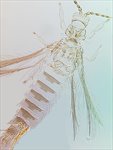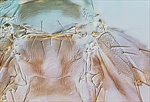Generic diagnosis
Female macropterous. Head wider than long; maxillary palps 3-segmented; compound eyes large with five pigmented facets; ocellar setae I absent, setae III longer than setae II; four pairs of postocular setae, pairs I and II mesad of compound eye, III and IV laterally. Antennae 8-segmented, segment I without paired dorso-apical setae, III and IV with sense-cones forked, III–VI with microtrichia on both surfaces. Pronotum with two pairs of long posteroangular setae; two pairs of posteromarginal setae. Mesonotum with median pair of setae far from posterior margin; campaniform sensilla absent anteromedially. Metanotum weakly sculptured; median pair of setae behind anterior margin; campaniform sensilla absent. Fore wings narrow, with veinal setae stout, first vein with long gap in setal row, three distal setae; second vein with about four setae; clavus with three veinal setae and one discal setae; posteromarginal fringe cilia wavy. Prosternal ferna weakly connected medially; basantra membranous, without setae; prospinasternum broad and transverse. Mesosternum with sternopleural sutures weak, endofurca with spinula. Metasternal endofurca without spinula. Tarsi 2-segmented. Tergites not distinctly divided from laterotergites, without ctenidia or craspeda; II–VII with three setae arranged in a line along lateral margin; VIII without posteromarginal comb; IX with only posterior pair of campaniform sensilla present, MD setae developed; X without median split. Sternites without discal setae or craspeda; II–VII with three pairs of posteromarginal setae, sternite VII with S1 setae in front of posterior margin.
Male similar to female; tergite IX with S1 setae short and stout; sternite VII with broad pore plate.
Biological data
There are no clear host associations recorded, although adults have been taken several times from the leaves of various crops in the family Fabaceae.
Distribution data
Apparently widespread across tropical Asia to northern Auatralia, and recorded in southern China (Wang, 2002).
Nomenclatural data
Bathrips Bhatti, 1962: 34. Type species Taeniothrips melanicornis Shumser Singh 1946, by monotypy.
Only two species are known in this Asian genus (ThripsWiki, 2020), and both of these are recorded from China:
jasminae Ananthakrishnan, 1968: 260.
melanicornis (Shumsher, 1946: 179). (Taeniothrips)
Relationship data
Thripidae sub-family Thripinae: this is a diverse group involving more than 230 genera. Within this group, relationships of Bathrips are unclear (Mound & Ng, 2009). It shares with Taeniothrips the absence of ocellar setae pair I and the presence of long setal pair III arising between the posterior ocelli, but the posterior margin of tergite VIII has no comb of microtrichia.
References
Mound LA & Ng YF (2009) An illustrated key to the genera of Thripinae (Thysanoptera) from South East Asia. Zootaxa 2265: 27–47.
ThripsWiki (2020) ThripsWiki - providing information on the World's thrips. <http://thrips.info/wiki/Main_Page>
Wang CL (2002) Thrips of Taiwan: Biology and Taxonomy. Special publication 99: 1–328. Taiwan Agricultural Research Institute, Taichung.





